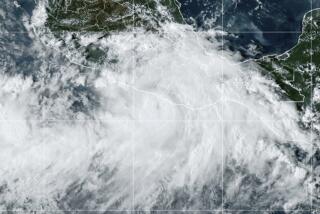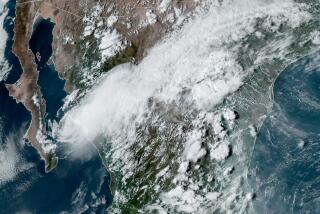Gulf Coast Is Spared a 2nd Hurricane
- Share via
HOUSTON — Tropical Storm Erika rumbled ashore near the U.S.-Mexico border Saturday but petered out quickly, allowing Gulf Coast residents, still cleaning up from the destruction of last month’s powerful hurricane, to exhale after days of anxiety.
The storm had been expected to develop into a low-grade hurricane. It might have -- but just barely, said Lixion Avila, an official with the National Hurricane Center in Miami.
The highest winds recorded by the Hurricane Center were 70 mph, Avila said, short of the 74-mph threshold for a formal hurricane declaration.
Avila said Gulf Coast residents benefited by Erika’s fast, due-west trajectory. Unlike last month’s Hurricane Claudette, which meandered through the Gulf for days, allowing it to gather strength before raking hundreds of miles of Texas shoreline, Erika had been a tropical storm only since Thursday.
What’s more, Erika weakened almost immediately when it passed quickly into the mountains and mesas of northern Mexico after coming ashore south of Brownsville, Texas, Avila said. Claudette, by comparison, wreaked havoc in communities that were surprisingly far from the coast, such as the city of Victoria, Texas.
“If the system had been over the Gulf of Mexico longer, it would have been a powerful hurricane,” Avila said. “But once it reached land it couldn’t feed on the power of the Gulf anymore.”
The storm brought as much as 6 inches of rain in some areas, and authorities cautioned that mudslides and small floods were still possible this weekend in northern Mexico. They remained particularly concerned about the border region’s colonias, shantytowns where basic services, such as flood control, are often lacking.
But as of Saturday evening, confirmed damage from Erika was light, officials said.
The storm brought down trees in the Mexican town of Matamoros. There were scattered power outages on both sides of the border, palm trees were uprooted and some signs were lost, but the most evident damage appeared to be to the roof of a fun-loving establishment on South Padre Island, Texas, called Tequila Frogs.
“I moved here five years ago. I declared it a hurricane-free zone and so far it’s working,” joked Dan Quandt, executive director of the South Padre Island Convention and Visitors Bureau. South Padre, a thin, north-south-oriented island on the extreme southern tip of Texas, is best known as one of the nation’s most popular, anything-goes spring break destinations.
“We did really well,” Quandt said.
That was an immense relief to a Gulf Coast that is still cleaning up from Claudette. Memories of the hurricane are so fresh that in towns like Palacios, Texas, the Federal Emergency Management Agency’s disaster recovery centers -- established to assist communities pummeled by that hurricane -- were among the public buildings closed to brace for Erika.
Claudette, which came ashore farther north along the central Texas coast, carried 100-mph bursts of wind, killed two people, destroyed nearly 150 homes and damaged more than 20,000 others. It caused as much as $100 million in damage.
More to Read
Sign up for Essential California
The most important California stories and recommendations in your inbox every morning.
You may occasionally receive promotional content from the Los Angeles Times.











